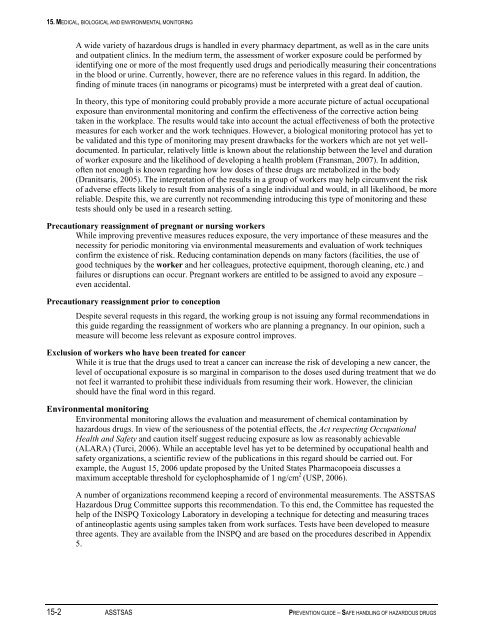Prevention Guide - Safe Handling of Hazardous Drugs - Irsst
Prevention Guide - Safe Handling of Hazardous Drugs - Irsst
Prevention Guide - Safe Handling of Hazardous Drugs - Irsst
You also want an ePaper? Increase the reach of your titles
YUMPU automatically turns print PDFs into web optimized ePapers that Google loves.
15. MEDICAL, BIOLOGICAL AND ENVIRONMENTAL MONITORING<br />
A wide variety <strong>of</strong> hazardous drugs is handled in every pharmacy department, as well as in the care units<br />
and outpatient clinics. In the medium term, the assessment <strong>of</strong> worker exposure could be performed by<br />
identifying one or more <strong>of</strong> the most frequently used drugs and periodically measuring their concentrations<br />
in the blood or urine. Currently, however, there are no reference values in this regard. In addition, the<br />
finding <strong>of</strong> minute traces (in nanograms or picograms) must be interpreted with a great deal <strong>of</strong> caution.<br />
In theory, this type <strong>of</strong> monitoring could probably provide a more accurate picture <strong>of</strong> actual occupational<br />
exposure than environmental monitoring and confirm the effectiveness <strong>of</strong> the corrective action being<br />
taken in the workplace. The results would take into account the actual effectiveness <strong>of</strong> both the protective<br />
measures for each worker and the work techniques. However, a biological monitoring protocol has yet to<br />
be validated and this type <strong>of</strong> monitoring may present drawbacks for the workers which are not yet welldocumented.<br />
In particular, relatively little is known about the relationship between the level and duration<br />
<strong>of</strong> worker exposure and the likelihood <strong>of</strong> developing a health problem (Fransman, 2007). In addition,<br />
<strong>of</strong>ten not enough is known regarding how low doses <strong>of</strong> these drugs are metabolized in the body<br />
(Dranitsaris, 2005). The interpretation <strong>of</strong> the results in a group <strong>of</strong> workers may help circumvent the risk<br />
<strong>of</strong> adverse effects likely to result from analysis <strong>of</strong> a single individual and would, in all likelihood, be more<br />
reliable. Despite this, we are currently not recommending introducing this type <strong>of</strong> monitoring and these<br />
tests should only be used in a research setting.<br />
Precautionary reassignment <strong>of</strong> pregnant or nursing workers<br />
While improving preventive measures reduces exposure, the very importance <strong>of</strong> these measures and the<br />
necessity for periodic monitoring via environmental measurements and evaluation <strong>of</strong> work techniques<br />
confirm the existence <strong>of</strong> risk. Reducing contamination depends on many factors (facilities, the use <strong>of</strong><br />
good techniques by the worker and her colleagues, protective equipment, thorough cleaning, etc.) and<br />
failures or disruptions can occur. Pregnant workers are entitled to be assigned to avoid any exposure –<br />
even accidental.<br />
Precautionary reassignment prior to conception<br />
Despite several requests in this regard, the working group is not issuing any formal recommendations in<br />
this guide regarding the reassignment <strong>of</strong> workers who are planning a pregnancy. In our opinion, such a<br />
measure will become less relevant as exposure control improves.<br />
Exclusion <strong>of</strong> workers who have been treated for cancer<br />
While it is true that the drugs used to treat a cancer can increase the risk <strong>of</strong> developing a new cancer, the<br />
level <strong>of</strong> occupational exposure is so marginal in comparison to the doses used during treatment that we do<br />
not feel it warranted to prohibit these individuals from resuming their work. However, the clinician<br />
should have the final word in this regard.<br />
Environmental monitoring<br />
Environmental monitoring allows the evaluation and measurement <strong>of</strong> chemical contamination by<br />
hazardous drugs. In view <strong>of</strong> the seriousness <strong>of</strong> the potential effects, the Act respecting Occupational<br />
Health and <strong>Safe</strong>ty and caution itself suggest reducing exposure as low as reasonably achievable<br />
(ALARA) (Turci, 2006). While an acceptable level has yet to be determined by occupational health and<br />
safety organizations, a scientific review <strong>of</strong> the publications in this regard should be carried out. For<br />
example, the August 15, 2006 update proposed by the United States Pharmacopoeia discusses a<br />
maximum acceptable threshold for cyclophosphamide <strong>of</strong> 1 ng/cm 2 (USP, 2006).<br />
A number <strong>of</strong> organizations recommend keeping a record <strong>of</strong> environmental measurements. The ASSTSAS<br />
<strong>Hazardous</strong> Drug Committee supports this recommendation. To this end, the Committee has requested the<br />
help <strong>of</strong> the INSPQ Toxicology Laboratory in developing a technique for detecting and measuring traces<br />
<strong>of</strong> antineoplastic agents using samples taken from work surfaces. Tests have been developed to measure<br />
three agents. They are available from the INSPQ and are based on the procedures described in Appendix<br />
5.<br />
15-2 ASSTSAS PREVENTION GUIDE – SAFE HANDLING OF HAZARDOUS DRUGS

















